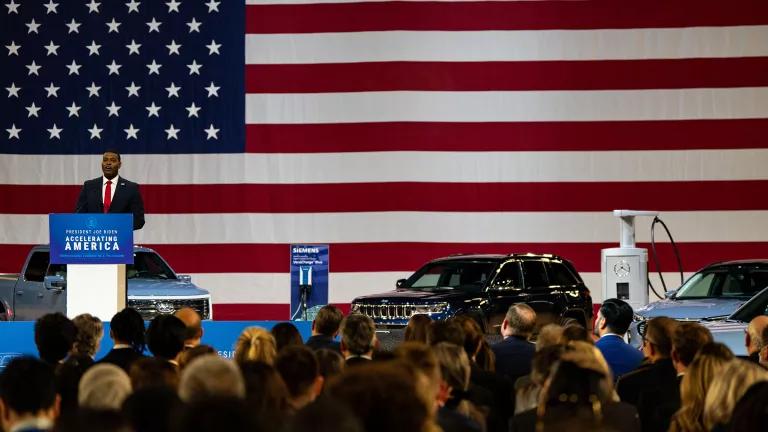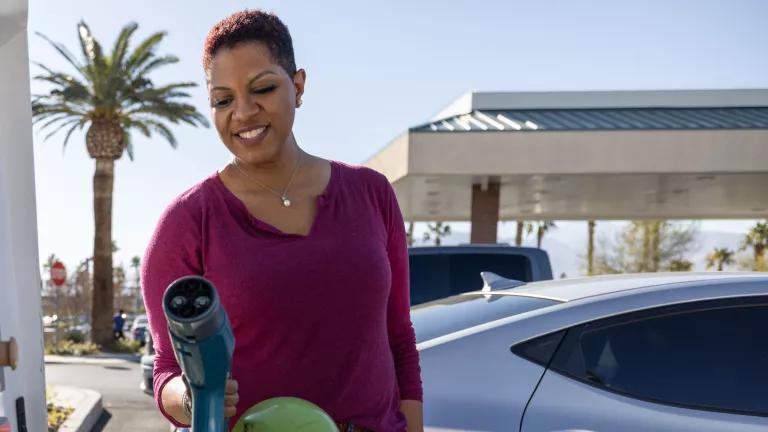We’re Suing to Defend a Key Transportation Rule
NRDC today leads a coalition in challenging the Trump Administration’s latest assault on the environment.
We are suing to defend and protect a key rule issued by the Federal Highway Administration (FHWA)—a performance standard for measuring and limiting carbon pollution from transportation sources. In January, the FHWA issued this bold rule to for the first time require regions and states to measure heat-trapping carbon pollution generated from vehicles traveling on the National Highway System and to set targets for reducing that pollution.
The rule is the final in a series under the Moving Ahead for Progress in the 21st Century or MAP-21 transportation law enacted in 2012. Collectively these rules would achieve the law’s promise to launch transportation into the 21st century by making it more performance-driven—a recommendation made by many analysts and groups, including the Bipartisan Policy Center.
It’s a simple but profound premise: Transportation plans must be more accountable for performance outcomes, including carbon pollution.
A 2016 report by the Congressional Budget Office (CBO) confirms the current lack of accountability, finding, “Spending on highways does not correspond very well with how the roads are used and valued.” CBO recommended three possible remedies for investing federal dollars more effectively, including performance management for transportation plans.
In addition, a just-released Government Accountability Office report calls for improved implementation of the transportation planning improvements in MAP-21. The report concludes:
As our past work has demonstrated, it is increasingly important to improve the effectiveness of surface transportation programs by establishing links to performance and measuring progress toward clear national goals in order to maximize the use of available resources.
Yet with no opportunity for public notice or comment, FHWA halted this commonsense performance standard, abruptly announcing it will “indefinitely delay” the greenhouse gas (GHG) sections of the larger Moving Ahead for Progress in the 21st Century (MAP-21) transportation rule. That sounds illegal because it is.
NRDC, Clean Air Carolina and U.S. PIRG challenge this unlawful move because transportation is the leading source of carbon pollution in the United States and our transportation sector produces more carbon pollution than the entire economies of every nation on earth save China, India and Russia. To tackle climate change we must limit pollution from our transportation system—and quickly.
Had the rule taken effect, regions and states would now be engaged in a process to measure—or benchmark—the carbon pollution emitted by vehicles on the national highway system to project how much it would grow in coming decades based on plans that receive federal assistance, and then set targets for reducing that pollution.
We don’t have to speculate what would happen with this rule because we are nine years into implementation of a similar law in California, SB 375.
Under SB 375, regions learned quickly that to cut carbon pollution from transportation, they needed to invest in choices that can help reduce the need to drive. Regions have spent billions improving public transportation choices such as light-rail and buses and creating new infrastructure for safe walking and biking. They have also created new innovative mobility choices such as the recently launched Ford Go Bike bikeshare system in the Bay Area, or the low-income electric carshare program in Los Angeles. The persistent theme across regions is to reduce reliance on driving by creating competitive, affordable, low-carbon transportation choices.
This investment comes with many benefits beyond reducing carbon pollution.
Southern California’s plan is projected to reduce congestion by 39% per capita. Sacramento will invest over $10 billion—nearly one-third of available revenues—in its public transit system, providing affordable mobility choices for tens of thousands of residents. And the Bay Area aims to reduce adverse health impacts associated with air quality, road safety, and physical inactivity by 10%, as well as reduce by tenfold the share spent on transportation and housing by low-income households.
By indefinitely delaying the GHG performance standard, FHWA is denying communities across the country access to cleaner air and more affordable mobility options to connect them to jobs and opportunity. It is also leaving in place a legacy of dangerous roads that results in nearly 36,000 traffic-related fatalities every year.
We are fighting to protect the interests of the overwhelming majority of those who commented in support of this rule. In fact, we’re pretty sure it was a record shattered for number of comments ever received in an FHWA rulemaking docket. As FHWA itself notes, “Supporting comments came from 91,695 citizens, 9 State DOTs, 24 MPOs, 19 U.S. Senators, 48 Members of the U.S. House of Representatives, over 100 cities, numerous local officials, over 100 businesses, and over 100 public interest, nonprofit and advocacy organizations.”
The carbon pollution performance standard was also strongly supported by Americans of all political stripes. In polling conducted in 2016, we learned that over 2/3 of Americans supported FHWA’s efforts to create it.
That’s why we’re fighting back in court against such an ill-conceived and detrimental step backward in critically needed progress on the environment.



